 Posted
Posted: 1/21/2020 | January 20th, 2020
As people become more conscious of their environmental impact on the world, there’s been an increased focus on air travel — and, over the past year, a corresponding increase in “flight shaming”. The term is coined from the Swedish
flygskam, which means “flight shame” i.e. you personally feel shame about flying but, unsurprisingly, it has devolved into shaming others for flying due to its carbon footprint.
After all, there is no denying that flying increases your personal carbon footprint — a lot. My carbon footprint is undoubtedly through the roof because of all my intense flying habits.
But what can we do? And is focusing on this issue really the best use of our efforts? Just exactly
how bad is flying really?
Air travel accounts for only
2.5% of global carbon emissions. In the US, flying accounted for
9% of transportation emissions, but only 3% of total carbon emissions. It’s a drop in the bucket when compared to
other industries in the United States:
- Transportation: 29%
- Electricity 28%
- Industry 22%
- Commercial/Residential 12%
- Agriculture 9%
So, when looking at the math, flying isn’t really the worst climate offender out there. There are far worse industries out there. Shouldn’t we focus on them?
Cutting down carbon emissions from flying isn’t going to make a big dent in total emissions.
And you can’t just shut off air travel. The world economy relies on it to function. We live in a globalized economy — and benefit from that — because of air travel. Ending all flights would end our modern economy.
Moreover, there are instances where flying is required. I mean, are we going to take boats across the ocean all the time? What if we have to rush to a sick loved one’s side? Driving might take too long.
To me, it seems that we could get bigger wins elsewhere.
But I’m not a scientist. So I called one up to ask about the environmental impact of air travel.
Michael Oppenheimer is a professor at Princeton University, co-founded the
Climate Action Network, and has been a leading scientist on climate change for over 30 years. He was one of the principal participants of the Intergovernmental Panel on Climate Change. He said:
If you’re a traveler, you have to worry about four things from aviation. One is just the carbon dioxide emissions…number two, you have to worry about the fact that particulate matter from jets can provide surfaces for the formation of clouds, and that that reflects some sunlight…the third thing would be…the production of tropospheric ozone [a greenhouse gas] through the emission of nitrogen oxides…and then there’s a fourth thing, which is that high-flying jets that actually enter the stratosphere can produce some…ozone, and at some altitudes, they may release particulate matter, which would encourage the destruction of ozone.
My conversation with Prof. Oppenheimer gave me pause. It’s just not our carbon footprint we need to worry about when we fly, which makes the total cost of our flights pretty bad. (But, since the carbon effect is the easiest documented, we’re going to focus on that here.) Further research showed that flying is pretty bad.
Most of the time.
While you can say that, generally speaking, flying is worse than any other mode of transportation, the science is tricky because, since there is a surprising number of variables, there’s really no good apples-to-apples comparison. Depending on the make, model, distance, and the number of passengers in your car, driving might be better — or worse — than flying. The same is true with a bus. How many passengers are on that bus?
According to the International Civil Aviation Organization (ICAO), a round-trip flight from NYC to LA produces 1,249 lbs. (566.4 kg) of carbon per person. A car getting an average of 20 miles per gallon produces 4,969.56 lbs. (2,254.15 kg) for the same trip for one person.
1
If you’re driving alone, especially over a long distance, it might better to fly. Yet, on that same trip, if you carpool with three other people, you can get your numbers down by a fourth, making driving the better option.
So it turns out there’s no one-size-fits-all answer. You can’t say “flying is bad, never fly” because sometimes it’s better to fly.
That said, a round-trip flight from Paris to London creates 246 lbs (111.5 kg) of carbon while taking the Eurostar (train) will create about
49 lbs (22.2 kg) of carbon.
From Vienna to Brussels, a flight will create 486 lbs (220.4 kg) while the new night train (which takes around 14 hours) will create
88 lbs (39.9 kg) per person.
The International Council on Clean Transportation also came to the same conclusion when they looked into it. It turns out figuring out what mode of transport is quite complicated. As you can see from their chart, no one transportation option is the best every time:
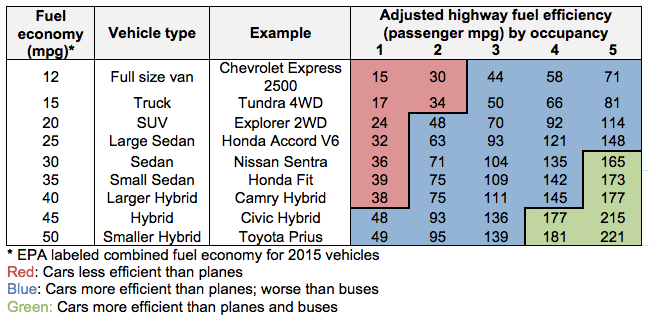
So what’s a traveler to do? I felt overwhelmed just researching this article and doing the math on all these example trips. I didn’t realize how complex this was. And, as I explain later, depending on the carbon calculate you use, your numbers can be wildly off. So what can you do? Here are some tips I learned in this process to help reduce the carbon footprint of flying:
1. Avoid short-haul flights –
A report from NASA showed that about 25% of airplane emissions occur during takeoff and landing, so if you go on a lot of short-haul flights, you tend to have a higher per-pound footprint. So, flying nonstop rather than a bunch of connecting flights is the better option environmentally.
The longer the distance, the more efficient flying becomes (
because cruising altitude requires less fuel than any other stage of flying). If you’re flying a short distance, consider driving or taking a train or bus instead.
2. Buy carbon offsets (or don’t actually) – Carbon offsets offer a way to balance out your pollution by investing in projects that reduce emissions of carbon dioxide or other greenhouse gases in the atmosphere. If you used one ton (2,000 pounds) of carbon, you can support a project like planting trees or clean water initiatives that would produce a saving in carbon equal to what you use (so the scale balances).
Websites such as
Green-e,
Gold Standard, and
Cool Effect can give you a list of good projects to support.
But, while these programs help, they aren’t super effective. For example, it takes
15-35 years for trees to grow big enough to capture carbon.
And carbon offsets just shift the burden of what you’re doing to somewhere else. It’s not an
actual reduction in carbon emissions; you’re just investing in something that you hope will take as much out as you put in.
In fact, in a
2017 study of offsets commissioned by the European Commission found that 85% of offset projects under the Kyoto Protocol’s Clean Development Mechanism (CDM) had failed to reduce emissions.
Much of my conversation with Prof. Oppenheimer centered on carbon offsets. He said,
Offsets are good if, and only if, they’re accountable, that is, you’re sure they’re producing the greenhouse gas benefit that they’re advertised at, and that’s sometimes hard to figure out because the emissions are not direct, they’re somewhere else…so, you want to only do offsets and count that as part of your greenhouse gas budget if they’re from an accounting system that’s comprehensive and reliable. Secondly, offsets are good if some have been designed to stimulate technological change or other changes that would not have happened so easily without the offset.
He also said that he could “imagine situations where offsets are fine, even beneficial, but there are a lot of situations where they are not and where they’re…far worse than doing the reduction at…the direct emission site.”
I think this is the point. Offsets don’t have strict controls, so you don’t know if they are really working. And it’s far better to force more efficiency from airlines and build up alternatives to flying in the first place. Much of my research showed that offsets, while making you feel good, aren’t as effective as fighting for reductions directly at their source.
So, you can buy them, but be really careful and do your research into the projects you’re supporting.
3. Fight for better flying – We need to put the pressure on airlines to improve fuel efficiency through new aircraft designs and operations, like implementing the usage of biofuels and planes that run on clean electricity, plus modernizing their fleets. For example, the new Dreamliner has very fuel-efficient engines that reduce CO2 emissions by about 20% in comparison to the planes it replaced. Pressure airlines and fly newer, more fuel-efficient planes when you can. Additionally,
try to fly an airline that is generally fuel-efficient.
4. Calculate your footprint – As we’ve seen, sometimes it’s better to fly. Sometimes it’s not. Use a carbon calculator for your trip to see which mode of transportation has the lowest carbon footprint for your trip. If flying is a bad option, look for alternatives like trains, ridesharing like BlaBlaCar, or the bus. Some suggested carbon calculators are:
However, I want to put a big caveat here. My team and I used a lot of calculators for this article. We each found a bunch and tested them ourselves to see if our numbers matched. Like peer review scientific papers, we kept checking each other’s work. We were incredibly shocked to find out just how much variation there was between the carbon calculators. My suggestion is to use multiple calculators to find out what your exact footprint is.
Prof. Oppeniemer concurred, saying, “If the calculator shows that the car is worse, I would believe that, because all this is very sensitive to the load factor. And also…since a lot of fuel is burned on takeoff and landing, the longer the flight, you may sort of amortize the trip if you’re in an airplane.”
5. Fly less – At the end of the day, flying less is the best way to reduce your carbon footprint. Taking lots of flights a year, even if you do some of the lifestyle changes we mention below, is still going to cause your personal footprint to be huge. While the above methods will work, the best you can really do is to look for alternatives as much as possible.
***
I think we should all fly less. I look for ways to fly less all the time. We all need to be more aware of our carbon footprint. But it’s also important to understand, total flight emissions are small compared to other industries. There are so many factors that go into personal carbon footprints that I think we can make a bigger difference through the day-to-day actions we take since, as we’ve seen, most industries have a bigger impact on emissions! Do things like:
- Buy things that last a long time
- Buy secondhand
- Buy local, not online (so much packaging waste)
- Reduce your plastic consumption
- Drive less
- Switch to a hybrid or electric car
- Eat less takeout to avoid the plastic and other waste that comes with it
- Eat less meat or go vegetarian or vegan
- Switch your home heating to renewable energy
- Change your incandescent light bulbs to LEDs
- Install low-flow showerheads and toilets
If you don’t fly a lot generally, the things you do every day can have a huge impact on your carbon footprint and help the environment. Let’s not lose the forest through the trees.
***
In today’s “cancel culture,” we’re all supposed to be perfect people — but those who cast the most stones are imperfect too.
We all are.
I don’t believe in flight shaming because, when does shaming someone ever work?
When people feel like their values are attacked, they harden their positions. If you shame someone, they will just do more of the same and become entrenched in their positions. Study after study has shown this to be true.
Telling the person they are bad – when no one ever wants to think of themselves as a bad person – won’t get you anywhere.
That’s not how human psychology works.
Instead, I believe in finding and presenting alternatives.
That’s how you affect change.
I’m not going to judge people who fly. Nor will I judge people who have decided the best way to live their values is to fly less.
If you’re worried about the environmental impact of flying, reduce your own footprint, educate your friends on why they should fly less and find alternative transportation, and contribute to some good organizations that are out there fighting for a greener world:
The world needs immediate action. And there’s a lot you can do to to help. If you want more effective change, donate to NGOs and sociopolitical groups that are pushing climate change action immediately — because the longer we wait, the worse it will get.
Support green-energy projects.
Fund the planting of trees.
Donate to land reclamation.
Fast action will get you more bang for your buck than anything else.
But whatever you do, don’t shame people for flying. That’s not going to do anything.
Book Your Trip: Logistical Tips and Tricks
Book Your Flight
Find a cheap flight by using
Skyscanner or
Momondo. They are my two favorite search engines because they search websites and airlines around the globe so you always know no stone is left unturned.
Book Your Accommodation
You can book your hostel with
Hostelworld as they have the largest inventory. If you want to stay somewhere other than a hostel, use
Booking.com as they consistently return the cheapest rates for guesthouses and cheap hotels.
Don’t Forget Travel Insurance
Travel insurance will protect you against illness, injury, theft, and cancellations. It’s comprehensive protection in case anything goes wrong. I never go on a trip without it as I’ve had to use it many times in the past. I’ve been using
World Nomads for ten years. My favorite companies that offer the best service and value are:
Looking for the best companies to save money with?
Check out my
resource page for the best companies to use when you travel! I list all the ones I use to save money when I travel – and that will save you time and money too!
Footnotes
1. There are a lot of emissions calculators out there, and many vary wildly. For flights, I went with the ICAO as it’s the most scientific. For car emissions, I used the Environmental Protection Agency (EPA).
Sources:
We did a lot of research for this post. While we linked to some in our articles, here’s some of the other sources we used for this post:
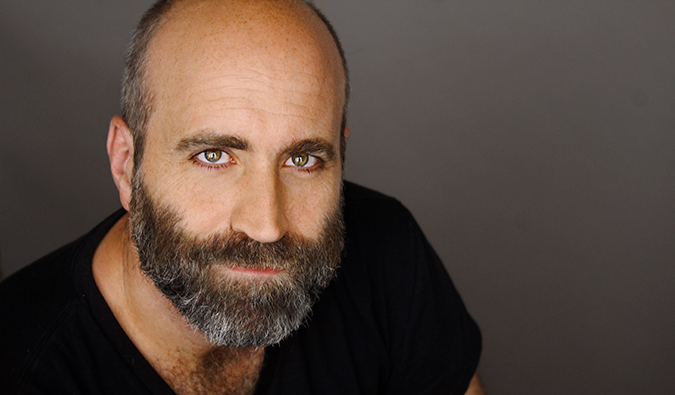 Posted: 01/27/2020 | January 27th, 2020
In 2010, I decided to spend the summer in NYC. I was two years into blogging and was making enough where I could afford a few months here. Still new to the industry, NYC was where all the legends of writing lived and I wanted to start making connections with my peers.
It was that summer I met Jason Cochran, a guidebook writer from Frommers, editor, and the man I would consider my mentor.
Though we never had any formal mentor/mentee relationship, Jason’s writing philosophy, advice, and feedback, especially on my first book, How to Travel the World on $50 a Day, has been instrumental in shaping me as a writer. Much of his philosophy has become mine and I don’t think I would have grown to where I am without him.
Last year, he finally published the book he’d been working on about tourism in America, called Here Lies America. (We featured it on our best books of 2019 list).
Today, we’re going to go behind the scenes of the book and talk to Jason on what does lie in America!
Nomadic Matt: Tell everyone about yourself.
Jason Cochran: I’ve been a travel writer for longer than I’ve felt like an adult. In the mid-‘90s, I kept a very early form of a travel blog on a two-year backpacking trip around the world. That blog became a career. I’ve written for more publications than I can count, including for a prime-time game show.
These days I’m the Editor-in-Chief of Frommers.com, where I also write two of its annual guidebooks, and I co-host a weekly radio show with Pauline Frommer on WABC. For me, history is always my way into a new place. In many ways, time is a form of travel, and understanding the past flexes a lot of the same intellectual muscles as understanding cultural differences.
So I have come to call myself a travel writer and a pop historian. That last term is something I just made up. Dan Rather made fun of me once for it. “Whatever that is,” he said. But it seems to fit. I like uncovering everyday history in ways that are funny, revealing, and casual, the way Bill Bryson and Sarah Vowell do.
What made you want to write this book?
Before I began researching, I just thought it would be funny. You know, sarcastic and ironic, about Americans going to graveyards and places of suffering just to buy lots of tacky souvenirs, eat ice cream, and wear dumb t-shirts. And, that’s still in there, for sure. We’re Americans and we like those things. Key chains will happen.
But that changed fast. For one, that would have become a very tired joke. It wouldn’t carry for three hundred pages. Things clicked for me early on, on the first of several cross-country research drives I took. I went to a place that I wasn’t taught about at school, and it clicked. I was at Andersonville in rural Georgia, where 13,000 out of 45,000 Civil War prisoners died in just 14 months. It was flat-out a concentration camp.
Yes, it turns out that concentration camps are as American as apple pie. The man who ran it was the only Confederate officer who was executed after the war. Southerners feared the victors would hang their leaders by the dozen, but that vengeance never materialized. Not for Jefferson Davis, not for Robert E. Lee—the guy who ran this camp poorly got the only public hanging. And he wasn’t even a born American. He was Swiss!
But that’s how important this place was at the time. Yet most of us have never even heard of it, except for a really bad low-budget movie on TNT in the ‘90s in which all the characters bellowed inspirational monologues as if they thought they were remaking Hoosiers.
So just getting my head around the full insanity of Andersonville’s existence was a big light bulb—our history is constantly undergoing whitewashing. Americans are always willfully trying to forget how violent and awful we can be to each other.
And Andersonville wasn’t even the only concentration camp in that war. There were a bunch in both the North and the South, and most of them had survival rates that were just as dismal. So that was another light bulb: There’s a story in why our society decided to preserve Andersonville but forget about a place like Chicago’s Camp Douglas, which was really just as nasty, except now it’s a high-rise housing project and there’s a Taco Bell and a frozen custard place where its gate once stood.
And did you know that the remains of 12,000 people from another Revolutionary War concentration camp are in a forgotten grave smack in the middle of Brooklyn? We think our major historic sites are sacred and that they are the pillars of our proud American story, but actually, how accurate can our sites be if they’re not even fairly chosen?
Posted: 01/27/2020 | January 27th, 2020
In 2010, I decided to spend the summer in NYC. I was two years into blogging and was making enough where I could afford a few months here. Still new to the industry, NYC was where all the legends of writing lived and I wanted to start making connections with my peers.
It was that summer I met Jason Cochran, a guidebook writer from Frommers, editor, and the man I would consider my mentor.
Though we never had any formal mentor/mentee relationship, Jason’s writing philosophy, advice, and feedback, especially on my first book, How to Travel the World on $50 a Day, has been instrumental in shaping me as a writer. Much of his philosophy has become mine and I don’t think I would have grown to where I am without him.
Last year, he finally published the book he’d been working on about tourism in America, called Here Lies America. (We featured it on our best books of 2019 list).
Today, we’re going to go behind the scenes of the book and talk to Jason on what does lie in America!
Nomadic Matt: Tell everyone about yourself.
Jason Cochran: I’ve been a travel writer for longer than I’ve felt like an adult. In the mid-‘90s, I kept a very early form of a travel blog on a two-year backpacking trip around the world. That blog became a career. I’ve written for more publications than I can count, including for a prime-time game show.
These days I’m the Editor-in-Chief of Frommers.com, where I also write two of its annual guidebooks, and I co-host a weekly radio show with Pauline Frommer on WABC. For me, history is always my way into a new place. In many ways, time is a form of travel, and understanding the past flexes a lot of the same intellectual muscles as understanding cultural differences.
So I have come to call myself a travel writer and a pop historian. That last term is something I just made up. Dan Rather made fun of me once for it. “Whatever that is,” he said. But it seems to fit. I like uncovering everyday history in ways that are funny, revealing, and casual, the way Bill Bryson and Sarah Vowell do.
What made you want to write this book?
Before I began researching, I just thought it would be funny. You know, sarcastic and ironic, about Americans going to graveyards and places of suffering just to buy lots of tacky souvenirs, eat ice cream, and wear dumb t-shirts. And, that’s still in there, for sure. We’re Americans and we like those things. Key chains will happen.
But that changed fast. For one, that would have become a very tired joke. It wouldn’t carry for three hundred pages. Things clicked for me early on, on the first of several cross-country research drives I took. I went to a place that I wasn’t taught about at school, and it clicked. I was at Andersonville in rural Georgia, where 13,000 out of 45,000 Civil War prisoners died in just 14 months. It was flat-out a concentration camp.
Yes, it turns out that concentration camps are as American as apple pie. The man who ran it was the only Confederate officer who was executed after the war. Southerners feared the victors would hang their leaders by the dozen, but that vengeance never materialized. Not for Jefferson Davis, not for Robert E. Lee—the guy who ran this camp poorly got the only public hanging. And he wasn’t even a born American. He was Swiss!
But that’s how important this place was at the time. Yet most of us have never even heard of it, except for a really bad low-budget movie on TNT in the ‘90s in which all the characters bellowed inspirational monologues as if they thought they were remaking Hoosiers.
So just getting my head around the full insanity of Andersonville’s existence was a big light bulb—our history is constantly undergoing whitewashing. Americans are always willfully trying to forget how violent and awful we can be to each other.
And Andersonville wasn’t even the only concentration camp in that war. There were a bunch in both the North and the South, and most of them had survival rates that were just as dismal. So that was another light bulb: There’s a story in why our society decided to preserve Andersonville but forget about a place like Chicago’s Camp Douglas, which was really just as nasty, except now it’s a high-rise housing project and there’s a Taco Bell and a frozen custard place where its gate once stood.
And did you know that the remains of 12,000 people from another Revolutionary War concentration camp are in a forgotten grave smack in the middle of Brooklyn? We think our major historic sites are sacred and that they are the pillars of our proud American story, but actually, how accurate can our sites be if they’re not even fairly chosen?
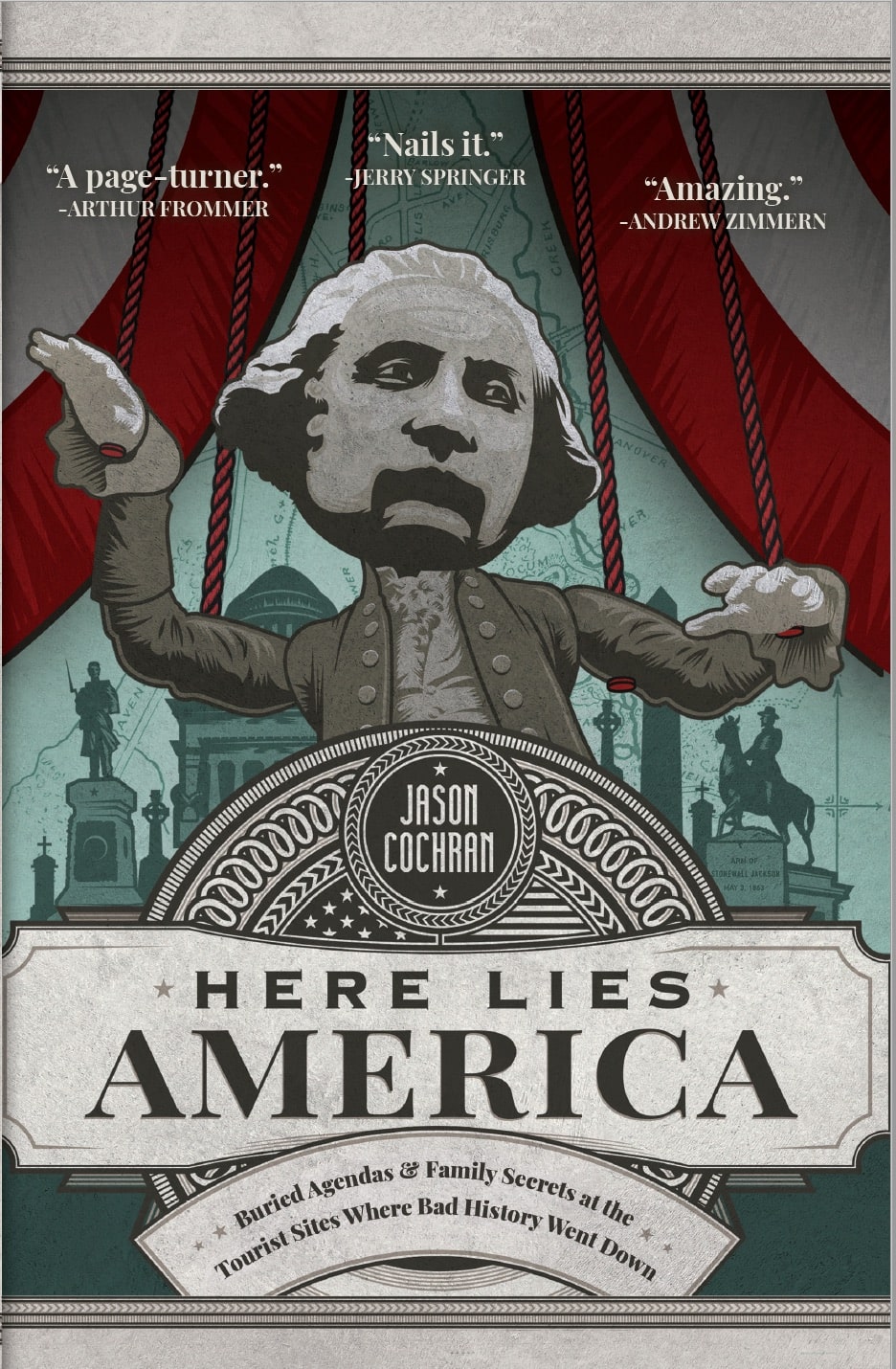 What was one of the most surprising things you learned from your research?
In almost no instance was a plaque, statue, or sign placed right after the historic event in question. Most of the monuments were actually installed many decades after the event. In the case of the Civil War, most of the memorials were erected in a boom that came a half-century after the last bullet was fired.
If you really get close to the plaques and read past the poetic inscriptions, it quickly becomes clear that our most beloved historic sites aren’t sanctified with artifacts but with propaganda placed there by people who weren’t even witnesses to the event. There was a vast network of women’s clubs that would help you order a statue for your own town out of a catalog, and they commissioned European sculptors who cashed the checks but privately grumbled about the poor taste of the tacky kitsch they were installing all over America.
We’re still dealing with what they did today. It’s what Charlottesville was about. But most people don’t realize these statues weren’t put there anywhere near the time of the war, or that they were the product of an orchestrated public relations machine. By powerful women!
What was one of the most surprising things you learned from your research?
In almost no instance was a plaque, statue, or sign placed right after the historic event in question. Most of the monuments were actually installed many decades after the event. In the case of the Civil War, most of the memorials were erected in a boom that came a half-century after the last bullet was fired.
If you really get close to the plaques and read past the poetic inscriptions, it quickly becomes clear that our most beloved historic sites aren’t sanctified with artifacts but with propaganda placed there by people who weren’t even witnesses to the event. There was a vast network of women’s clubs that would help you order a statue for your own town out of a catalog, and they commissioned European sculptors who cashed the checks but privately grumbled about the poor taste of the tacky kitsch they were installing all over America.
We’re still dealing with what they did today. It’s what Charlottesville was about. But most people don’t realize these statues weren’t put there anywhere near the time of the war, or that they were the product of an orchestrated public relations machine. By powerful women!
 I wrote a line in the book: “Having a Southern heritage is like having herpes—you can forget you have it, you can deny it, but it inevitably bubbles up and requires attention.” These issues aren’t going away.
Places we think of as holy ground, like Arlington National Cemetery, often have some pretty shocking origin stories. Arlington started because some guy got pissed off at Robert E. Lee and started buying corpses in his rose garden to get back at him! That’s our hallowed national burial ground: a nasty practical joke, like the Burn Book from Mean Girls. Dig a little and you find more revolting secrets, like how the incredible number of people buried under the wrong headstone, or the time the government put the remains of a Vietnam soldier in the Tomb of the Unknowns. They pretty much knew his identity, but Ronald Reagan really wanted a TV photo op. So they sealed all the soldier’s belongings in the coffin with him so that no one would figure it out.
They eventually had to admit they’d lied and gave the soldier’s body back to his mom. But if a thing like that happens in a place like Arlington, can the rest of our supposedly sacred sites be taken at face value at all?
It goes a lot deeper. At Ford’s Theatre and the surrender house at Appomattox, the site we visit isn’t even real. They’re fakes! The original buildings are long gone but visitors are rarely told that. The tale’s moral is what’s valued, not the authenticity.
What can visiting these sites teach us about how we remember our past?
Once you realize that all historic sites have been cultivated by someone who wanted to define your understanding of it, you learn how to use critical thinking as a traveler. All it takes is asking questions. One of the most fun threads in the book kicks off when I go to Oakland, a historic but touristy cemetery in Atlanta. I spot an ignored gravestone that piqued my interest. I’d never heard of the name of the woman: Orelia Key Bell. The info desk didn’t have her listed among the notable graves. She was born around the 1860s, which was a very eventful time in Atlanta.
So I took out my phone and right there on her grave, I Googled her. I researched her whole life so I could appreciate what I was seeing. It turned out she was a major poet of her time. I stood there reading PDFs of her books at her feet. Granted, her stuff was dreary, painfully old-fashioned. I wrote that her style of writing didn’t fall out of fashion so much as it was yanked down and clubbed by Hemingway.
But reading her writing at her grave made me feel wildly connected to the past. We almost never go to old places and look deeper. We usually let things remain dead. We accept what’s on the sign or the plaque as gospel, and I’m telling you, almost nothing ever reaches us in a state of purity.
I wrote a line in the book: “Having a Southern heritage is like having herpes—you can forget you have it, you can deny it, but it inevitably bubbles up and requires attention.” These issues aren’t going away.
Places we think of as holy ground, like Arlington National Cemetery, often have some pretty shocking origin stories. Arlington started because some guy got pissed off at Robert E. Lee and started buying corpses in his rose garden to get back at him! That’s our hallowed national burial ground: a nasty practical joke, like the Burn Book from Mean Girls. Dig a little and you find more revolting secrets, like how the incredible number of people buried under the wrong headstone, or the time the government put the remains of a Vietnam soldier in the Tomb of the Unknowns. They pretty much knew his identity, but Ronald Reagan really wanted a TV photo op. So they sealed all the soldier’s belongings in the coffin with him so that no one would figure it out.
They eventually had to admit they’d lied and gave the soldier’s body back to his mom. But if a thing like that happens in a place like Arlington, can the rest of our supposedly sacred sites be taken at face value at all?
It goes a lot deeper. At Ford’s Theatre and the surrender house at Appomattox, the site we visit isn’t even real. They’re fakes! The original buildings are long gone but visitors are rarely told that. The tale’s moral is what’s valued, not the authenticity.
What can visiting these sites teach us about how we remember our past?
Once you realize that all historic sites have been cultivated by someone who wanted to define your understanding of it, you learn how to use critical thinking as a traveler. All it takes is asking questions. One of the most fun threads in the book kicks off when I go to Oakland, a historic but touristy cemetery in Atlanta. I spot an ignored gravestone that piqued my interest. I’d never heard of the name of the woman: Orelia Key Bell. The info desk didn’t have her listed among the notable graves. She was born around the 1860s, which was a very eventful time in Atlanta.
So I took out my phone and right there on her grave, I Googled her. I researched her whole life so I could appreciate what I was seeing. It turned out she was a major poet of her time. I stood there reading PDFs of her books at her feet. Granted, her stuff was dreary, painfully old-fashioned. I wrote that her style of writing didn’t fall out of fashion so much as it was yanked down and clubbed by Hemingway.
But reading her writing at her grave made me feel wildly connected to the past. We almost never go to old places and look deeper. We usually let things remain dead. We accept what’s on the sign or the plaque as gospel, and I’m telling you, almost nothing ever reaches us in a state of purity.
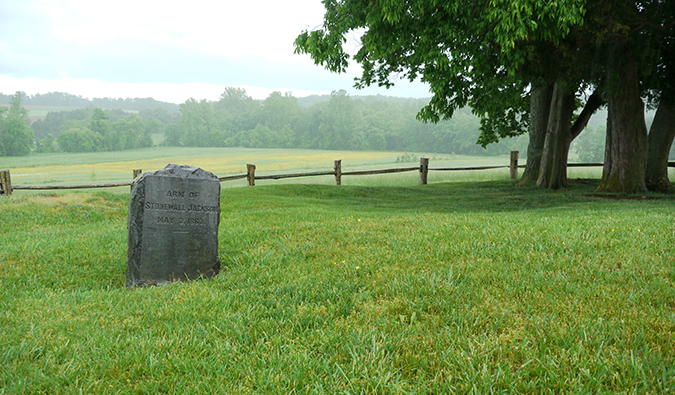 I figured that if I was going to probe all these strangers, I had to be fair and probe someone I knew. I decided to look into an untimely death in my own family, a great-grandfather who had died in a train wreck in 1909. That was the beginning and the end of the tale in my family: “Your great-great grandfather died in a train wreck up in Toccoa.”
But almost as soon as I started looking deeper, I discovered something truly shocking—he had been murdered. Two young Black men were accused in rural South Carolina for sabotaging his train and killing him. You’d think at least someone in my family would have known this! But no one had ever looked into it before!
Here Lies America follows their trail. Who were these guys? Why would they want to kill him? I went to where their village used to be, I started digging into court documents from their murder trial. Let me tell you, the shockers came flooding. Like, I found they may have killed him because they wanted to protect a sacred old Cherokee burial mound from destruction. There was this crazy, larger-than-life forgotten story happening in my own damn family.
My experience with that poet’s grave has a happy coda. Last week, someone told me that Orelia Key Bell and her companion are now officially part of the guided tour of Oakland. The simple act of looking deeper had revived a forgotten life and put her back on the record. That’s what visiting these sites can do—but you have to look behind the veneer, the way I do with dozens of attractions in my book. This is the essence of travel, isn’t it? Getting to a core understanding of the truth of a place.
A lot of what you wrote showed how whitewashed many of these historical sites are. How do we as travelers dig deeper to get to the real history?
Remember that pretty much everything you see at a historic site or museum was intentionally placed there or left there by someone. Ask yourself why. Ask who. And definitely ask when, because the climate of later years often twists interpretation of the past. It’s basic content analysis, really, which is something we’re really bad at in a consumer society.
Americans have it drilled into them to never question the tropes of our patriotism. If we learned about in grade school, we assume it’s a settled matter, and if you press it, you’re somehow an insurgent. Now, more than any other time in history, it’s easier than ever to call up primary sources about any era you want. If you want to go back to what our society really is, if you want to try to figure out how we wandered into the shattered shambles we’re in today, you have to be honest about the forces that created the image that, until recently, many of us believed we really were.
I figured that if I was going to probe all these strangers, I had to be fair and probe someone I knew. I decided to look into an untimely death in my own family, a great-grandfather who had died in a train wreck in 1909. That was the beginning and the end of the tale in my family: “Your great-great grandfather died in a train wreck up in Toccoa.”
But almost as soon as I started looking deeper, I discovered something truly shocking—he had been murdered. Two young Black men were accused in rural South Carolina for sabotaging his train and killing him. You’d think at least someone in my family would have known this! But no one had ever looked into it before!
Here Lies America follows their trail. Who were these guys? Why would they want to kill him? I went to where their village used to be, I started digging into court documents from their murder trial. Let me tell you, the shockers came flooding. Like, I found they may have killed him because they wanted to protect a sacred old Cherokee burial mound from destruction. There was this crazy, larger-than-life forgotten story happening in my own damn family.
My experience with that poet’s grave has a happy coda. Last week, someone told me that Orelia Key Bell and her companion are now officially part of the guided tour of Oakland. The simple act of looking deeper had revived a forgotten life and put her back on the record. That’s what visiting these sites can do—but you have to look behind the veneer, the way I do with dozens of attractions in my book. This is the essence of travel, isn’t it? Getting to a core understanding of the truth of a place.
A lot of what you wrote showed how whitewashed many of these historical sites are. How do we as travelers dig deeper to get to the real history?
Remember that pretty much everything you see at a historic site or museum was intentionally placed there or left there by someone. Ask yourself why. Ask who. And definitely ask when, because the climate of later years often twists interpretation of the past. It’s basic content analysis, really, which is something we’re really bad at in a consumer society.
Americans have it drilled into them to never question the tropes of our patriotism. If we learned about in grade school, we assume it’s a settled matter, and if you press it, you’re somehow an insurgent. Now, more than any other time in history, it’s easier than ever to call up primary sources about any era you want. If you want to go back to what our society really is, if you want to try to figure out how we wandered into the shattered shambles we’re in today, you have to be honest about the forces that created the image that, until recently, many of us believed we really were.
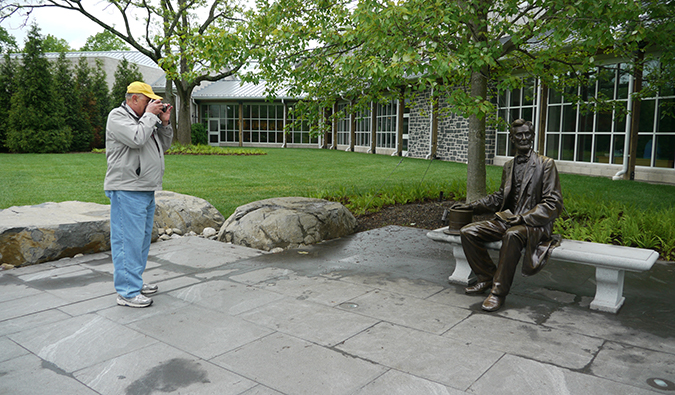 Do you think Americans have a problem talking about their history? If so, why is that?
There’s a phrase, and I forget who said it—maybe James Baldwin?-but it goes, “Americans are better at thinking with their feelings than about them.” We go by feels, not so much by facts. We do love to cling to a tidy mythology of how free and wonderful our country always was. It reassures us. We probably need it. After all, in America, where we all come from different places, our national self-belief is our main cultural glue. So we can’t resist prettying up the horrible things we do.
But make no mistake: Violence was the foundation of power in the 1800s, and violence is still a foundation of our values and entertainment today. We have yet to come to terms with that. Our way of dealing with violence is usually to convince ourselves it’s noble.
And if we can’t make pain noble, we try to erase it. It’s why the place where McKinley was shot, in Buffalo, lies under a road now. That was intentional so that it would be forgotten by anarchists. McKinley was given no significant pilgrimage spot where he died, but right after that death, his fans paid for a monument by Burnside’s Bridge in Antietam, because as a youth, he once served coffee to soldiers.
That’s the reason: “personally and without orders served hot coffee,” it reads—it’s hilarious. That is our national mythmaking in a nutshell: Don’t pay attention to the place that raises tough questions about imperialism and economic disparity, but put up an expensive tribute to a barista.
What is the main takeaway you’d like readers to take away from your book?
You may not know where you came from as well as you think you do. And we as a society definitely haven’t asked enough questions about who shaped the information we grew up with. Americans are finally ready to hear some truth.
Jason Cochran is the author of Here Lies America: Buried Agendas and Family Secrets at the Tourist Sites Where Bad History Went Down. He’s been a writer since mid-1990s, a commentator on CBS and AOL, and works today as editor-in-chief of Frommers.com and as co-host of the Frommer Travel Show on WABC. Jason was twice awarded “Guide Book of the Year” by the Lowell Thomas Awards and the North American Travel Journalists Association.
Do you think Americans have a problem talking about their history? If so, why is that?
There’s a phrase, and I forget who said it—maybe James Baldwin?-but it goes, “Americans are better at thinking with their feelings than about them.” We go by feels, not so much by facts. We do love to cling to a tidy mythology of how free and wonderful our country always was. It reassures us. We probably need it. After all, in America, where we all come from different places, our national self-belief is our main cultural glue. So we can’t resist prettying up the horrible things we do.
But make no mistake: Violence was the foundation of power in the 1800s, and violence is still a foundation of our values and entertainment today. We have yet to come to terms with that. Our way of dealing with violence is usually to convince ourselves it’s noble.
And if we can’t make pain noble, we try to erase it. It’s why the place where McKinley was shot, in Buffalo, lies under a road now. That was intentional so that it would be forgotten by anarchists. McKinley was given no significant pilgrimage spot where he died, but right after that death, his fans paid for a monument by Burnside’s Bridge in Antietam, because as a youth, he once served coffee to soldiers.
That’s the reason: “personally and without orders served hot coffee,” it reads—it’s hilarious. That is our national mythmaking in a nutshell: Don’t pay attention to the place that raises tough questions about imperialism and economic disparity, but put up an expensive tribute to a barista.
What is the main takeaway you’d like readers to take away from your book?
You may not know where you came from as well as you think you do. And we as a society definitely haven’t asked enough questions about who shaped the information we grew up with. Americans are finally ready to hear some truth.
Jason Cochran is the author of Here Lies America: Buried Agendas and Family Secrets at the Tourist Sites Where Bad History Went Down. He’s been a writer since mid-1990s, a commentator on CBS and AOL, and works today as editor-in-chief of Frommers.com and as co-host of the Frommer Travel Show on WABC. Jason was twice awarded “Guide Book of the Year” by the Lowell Thomas Awards and the North American Travel Journalists Association.
 Updated: 01/26/2020 | January 26th, 2020
Every year, tens of thousands of people
Updated: 01/26/2020 | January 26th, 2020
Every year, tens of thousands of people 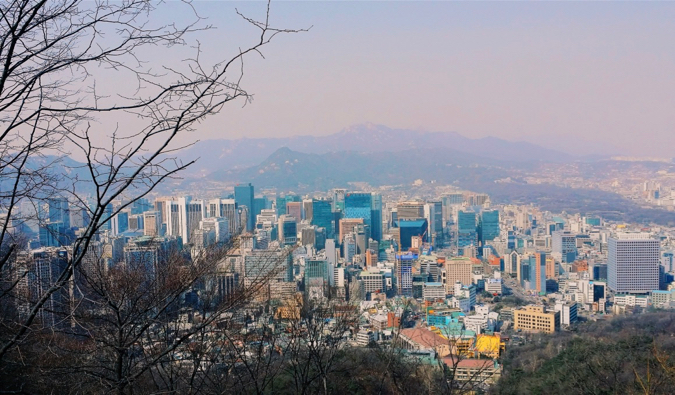 South Korea is one of the best places — if not the best — to teach English overseas. Jobs are abundant, the pay averages $1,600-2,600 USD per month, and you get awesome benefits, like a contract completion bonus, free housing, and airfare reimbursement.
A lot of recent college graduates are attracted to Korea because of the money, benefits, and the fact that Korea takes many first-time teachers. If you don’t have any experience, this country is one of the best options for you. As a place to live, Korea has plenty of things going for it: the food is delicious, the country is dirt cheap, and the people are friendly.
Plus you will find lots of other international young expats there. Since you earn so much money in a country with such a low cost of living, most people leave having paid off a substantial portion of their debts! You could easily walk away after a year of teaching with your loans (school or non-school) paid off AND money for travel!
South Korea is one of the best places — if not the best — to teach English overseas. Jobs are abundant, the pay averages $1,600-2,600 USD per month, and you get awesome benefits, like a contract completion bonus, free housing, and airfare reimbursement.
A lot of recent college graduates are attracted to Korea because of the money, benefits, and the fact that Korea takes many first-time teachers. If you don’t have any experience, this country is one of the best options for you. As a place to live, Korea has plenty of things going for it: the food is delicious, the country is dirt cheap, and the people are friendly.
Plus you will find lots of other international young expats there. Since you earn so much money in a country with such a low cost of living, most people leave having paid off a substantial portion of their debts! You could easily walk away after a year of teaching with your loans (school or non-school) paid off AND money for travel!
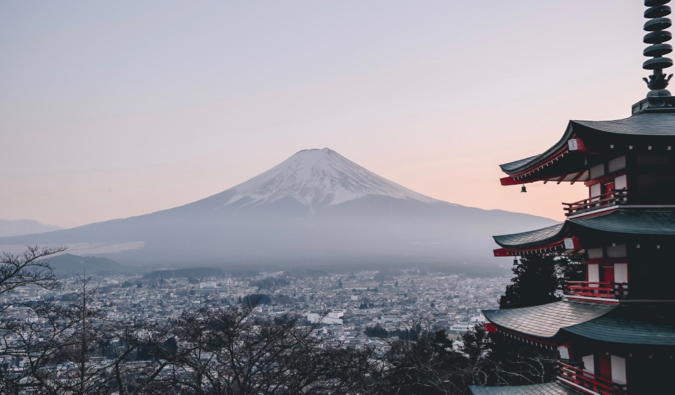
 The Middle East lures many teachers in for one reason: its salary packages. Middle Eastern countries offer incredibly large salaries (up to $70,000 USD per year for an experienced teacher), lots of benefits, and no taxes. A teacher can walk away with around $40,000 USD after one year.
However, this is no place for the recent college graduate. These countries want certified and experienced teachers. If you couldn’t teach at a public school in your home country, you have little chance of getting a job in this part of the world. As such, most of the teachers here are older and more settled and have families.
The Middle East lures many teachers in for one reason: its salary packages. Middle Eastern countries offer incredibly large salaries (up to $70,000 USD per year for an experienced teacher), lots of benefits, and no taxes. A teacher can walk away with around $40,000 USD after one year.
However, this is no place for the recent college graduate. These countries want certified and experienced teachers. If you couldn’t teach at a public school in your home country, you have little chance of getting a job in this part of the world. As such, most of the teachers here are older and more settled and have families.

 As
As 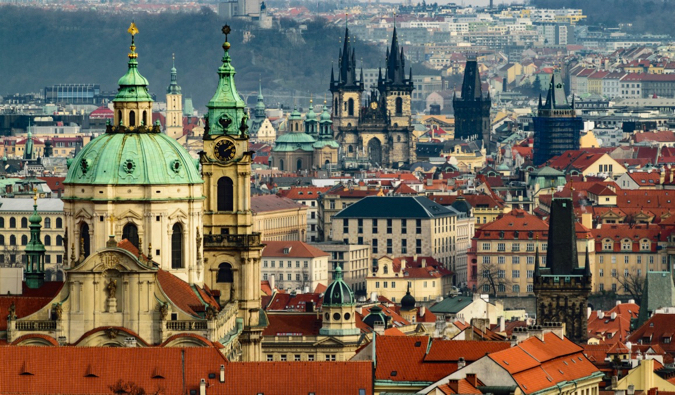 Prague has a seemingly abundant supply of teaching jobs. The city has grown in size over the last few years, attracting a variety of tech start-ups and expats, which has created a lot more job opportunities for teachers.
While it’s very hard to get a job in the public school system or a university, there are plenty of language schools in the city to choose from. The pay isn’t as high as other countries in the world and there are few benefits (especially when compared to Asia or the Middle East), but you’re a stone’s throw away from everywhere in
Prague has a seemingly abundant supply of teaching jobs. The city has grown in size over the last few years, attracting a variety of tech start-ups and expats, which has created a lot more job opportunities for teachers.
While it’s very hard to get a job in the public school system or a university, there are plenty of language schools in the city to choose from. The pay isn’t as high as other countries in the world and there are few benefits (especially when compared to Asia or the Middle East), but you’re a stone’s throw away from everywhere in 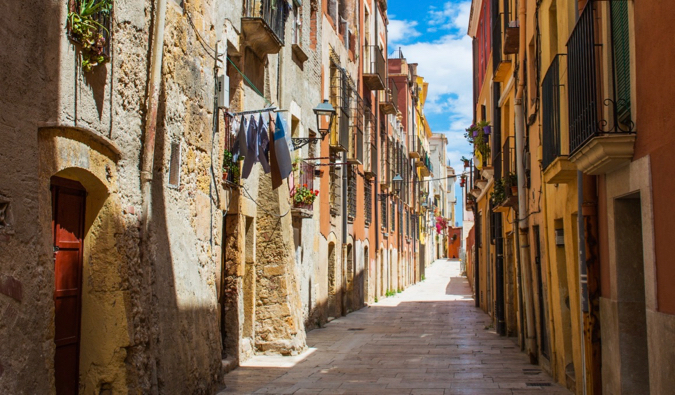
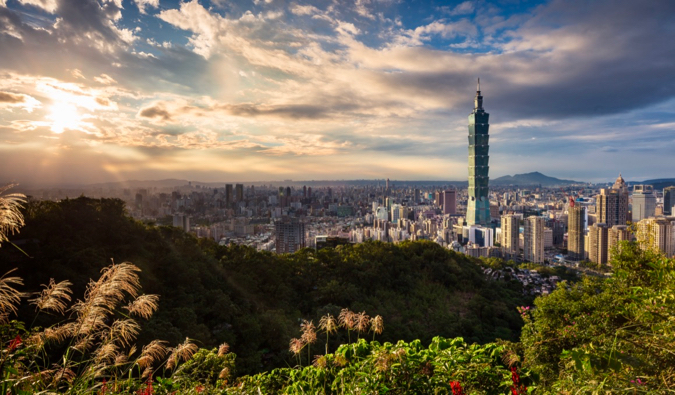 Taiwan is an excellent country to teach English in, thanks to lots of job opportunities (though they tend to be with young kids), high salaries, benefits similar to South Korea, and lots of other young teachers to share a social life with. The country places a high importance on learning English, and you’ll be able to find freelance tutor opportunities besides your regular, steady teaching job!
I loved my time in Taiwan, made some wonderful friends, and adapted to a completely new culture.
Taiwan is an excellent country to teach English in, thanks to lots of job opportunities (though they tend to be with young kids), high salaries, benefits similar to South Korea, and lots of other young teachers to share a social life with. The country places a high importance on learning English, and you’ll be able to find freelance tutor opportunities besides your regular, steady teaching job!
I loved my time in Taiwan, made some wonderful friends, and adapted to a completely new culture.
 This was something that didn’t exist when I was teaching. Thanks to the Internet, you no longer have to be tied to one location to teach Teaching online is becoming more popular as a way to make money while working remotely. Platforms like
This was something that didn’t exist when I was teaching. Thanks to the Internet, you no longer have to be tied to one location to teach Teaching online is becoming more popular as a way to make money while working remotely. Platforms like 
 Posted: 1/23/2020 | January 23rd, 2020
If you’re like me, you know how hard New Year’s resolutions are to keep. “New year, new you” starts with the best intentions, but after a couple of months, it’s back to new year, old you.
Old habits die hard, but they can be broken if they are replaced with good ones.
We’re at the start of a new year (and decade), so — as someone who loves a good cliché — I’m going to use this time to build the habits that create a better version of me.
After many years of trying (and writing copious and annoying blog posts about it), last year
Posted: 1/23/2020 | January 23rd, 2020
If you’re like me, you know how hard New Year’s resolutions are to keep. “New year, new you” starts with the best intentions, but after a couple of months, it’s back to new year, old you.
Old habits die hard, but they can be broken if they are replaced with good ones.
We’re at the start of a new year (and decade), so — as someone who loves a good cliché — I’m going to use this time to build the habits that create a better version of me.
After many years of trying (and writing copious and annoying blog posts about it), last year  Posted: 1/21/2020 | January 20th, 2020
As people become more conscious of their environmental impact on the world, there’s been an increased focus on air travel — and, over the past year, a corresponding increase in “flight shaming”. The term is coined from the Swedish flygskam, which means “flight shame” i.e. you personally feel shame about flying but, unsurprisingly, it has devolved into shaming others for flying due to its carbon footprint.
After all, there is no denying that flying increases your personal carbon footprint — a lot. My carbon footprint is undoubtedly through the roof because of all my intense flying habits.
But what can we do? And is focusing on this issue really the best use of our efforts? Just exactly how bad is flying really?
Air travel accounts for only
Posted: 1/21/2020 | January 20th, 2020
As people become more conscious of their environmental impact on the world, there’s been an increased focus on air travel — and, over the past year, a corresponding increase in “flight shaming”. The term is coined from the Swedish flygskam, which means “flight shame” i.e. you personally feel shame about flying but, unsurprisingly, it has devolved into shaming others for flying due to its carbon footprint.
After all, there is no denying that flying increases your personal carbon footprint — a lot. My carbon footprint is undoubtedly through the roof because of all my intense flying habits.
But what can we do? And is focusing on this issue really the best use of our efforts? Just exactly how bad is flying really?
Air travel accounts for only  So what’s a traveler to do? I felt overwhelmed just researching this article and doing the math on all these example trips. I didn’t realize how complex this was. And, as I explain later, depending on the carbon calculate you use, your numbers can be wildly off. So what can you do? Here are some tips I learned in this process to help reduce the carbon footprint of flying:
1. Avoid short-haul flights –
So what’s a traveler to do? I felt overwhelmed just researching this article and doing the math on all these example trips. I didn’t realize how complex this was. And, as I explain later, depending on the carbon calculate you use, your numbers can be wildly off. So what can you do? Here are some tips I learned in this process to help reduce the carbon footprint of flying:
1. Avoid short-haul flights – 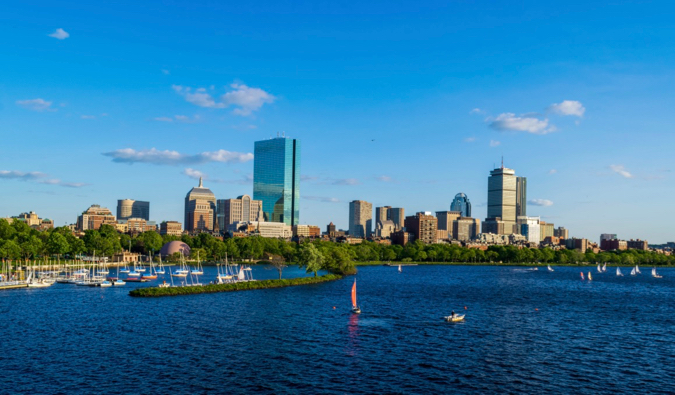 Posted: 1/18/2020 | January 18th, 2020
With its historic colonial buildings, die-hard sports fans, and lively nightlife,
Posted: 1/18/2020 | January 18th, 2020
With its historic colonial buildings, die-hard sports fans, and lively nightlife, 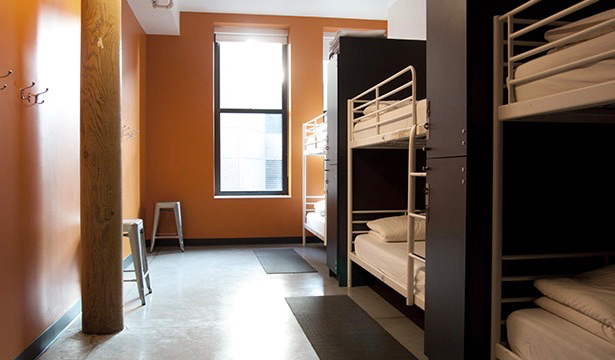


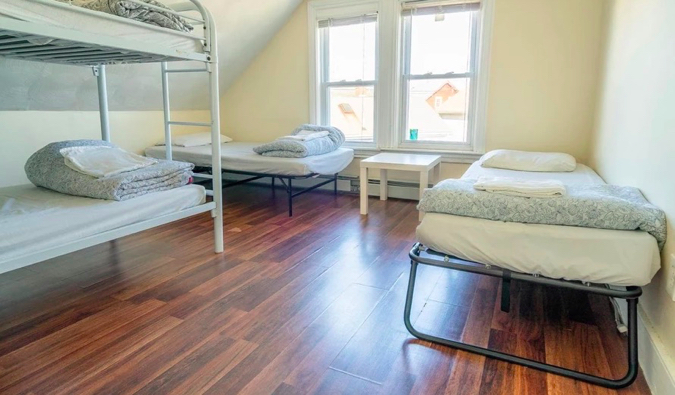 Located in an old house a few miles outside of the city center (but close to the JFK Library),
Located in an old house a few miles outside of the city center (but close to the JFK Library), 
 Available from June through September, this is easily the coolest place to stay in town: a functional sailing vessel,
Available from June through September, this is easily the coolest place to stay in town: a functional sailing vessel,